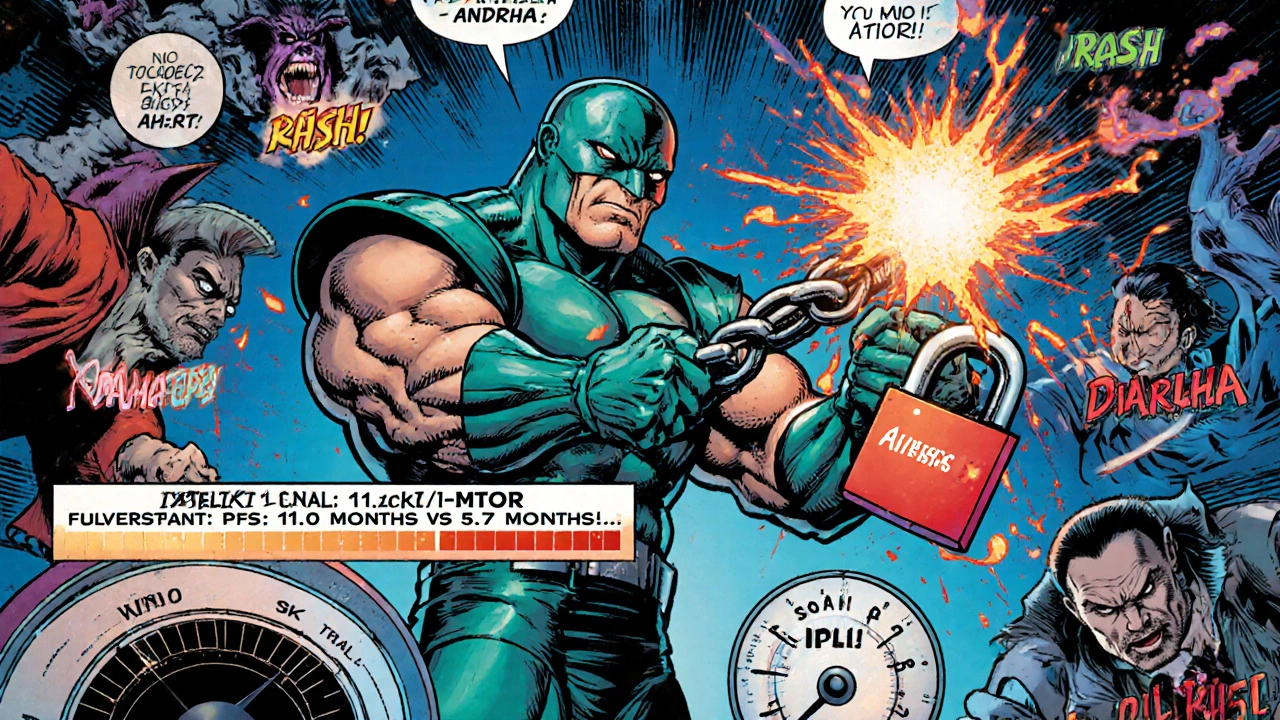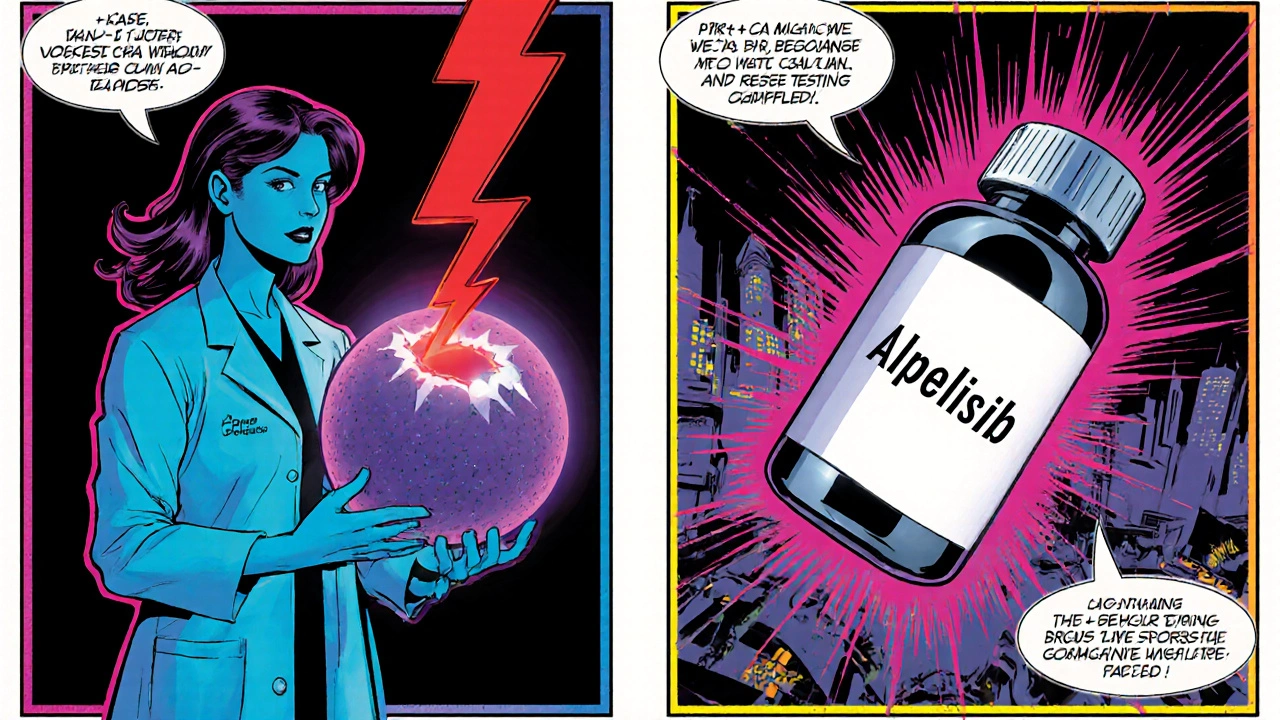Alpelisib Treatment Decision Tool
Answer a few questions to determine if alpelisib is appropriate for your treatment plan based on clinical evidence from SOLAR-1 trial and real-world data.
Key Takeaways
- Alpelisib is a selective PI3Kα inhibitor approved for HR⁺/HER2‑negative breast cancer with a PIK3CA mutation.
- The drug works by shutting down the PI3K‑AKT‑mTOR pathway that drives tumor growth in mutated cells.
- Clinical data from the SOLAR‑1 trial show a 30% median progression‑free survival gain when alpelisib is added to endocrine therapy.
- Testing for the PIK3CA mutation is essential; a companion diagnostic is FDA‑cleared.
- Common side‑effects-hyperglycemia, rash, and diarrhea-require proactive monitoring and dose adjustments.
Personalized Medicine in Breast Cancer
Personalized medicine tailors treatment to the genetic makeup of a patient’s tumor. In hormone‑receptor‑positive (HR⁺), HER2‑negative breast cancer, the discovery that about 40% of tumors carry a PIK3CA mutation sparked a new wave of targeted drugs. By matching a therapy to that mutation, clinicians can spare patients the toxicity of chemotherapy while achieving deeper, longer responses.
How Alpelisib Works: Targeting the PI3Kα Pathway
When it comes to targeted cancer therapy, alpelisib is a selective PI3Kα inhibitor approved for HR⁺/HER2‑negative breast cancer with a PIK3CA mutation. The PI3K‑AKT‑mTOR cascade controls cell growth and survival. A mutant PIK3CA gene locks the pathway in the “on” position, helping cancer cells proliferate. By blocking the alpha isoform of PI3K, alpelisib restores normal signaling and makes tumor cells more vulnerable to hormone‑blocking agents.
Clinical Evidence: The SOLAR‑1 Trial and Real‑World Data
The pivotal Phase III SOLAR‑1 trial enrolled over 1,800 patients with advanced HR⁺/HER2‑negative disease. In the PIK3CA‑mutated cohort, adding alpelisib to fulvestrant extended median progression‑free survival (PFS) from 5.7months to 11.0months-a 30‑month relative improvement. Overall survival data, still maturing, already hint at a survival benefit of roughly 8months.
Real‑world registries published in 2024 confirm these gains across diverse practice settings. Median time on treatment rose to 9.3months, and objective response rates climbed to 41% when physicians adhered to recommended glucose monitoring and dose‑adjustment protocols.

Who Benefits? Testing for PIK3CA Mutations
Before prescribing alpelisib, oncologists must confirm the presence of a PIK3CA mutation. The FDA‑cleared companion diagnostic FoundationOne CDx uses next‑generation sequencing on tumor tissue or circulating tumor DNA (ctDNA). A positive result unlocks the drug; a wild‑type result steers therapy toward CDK4/6 inhibitors or chemotherapy.
Combining Alpelisib with Endocrine Therapy and CDK4/6 Inhibitors
Alpelisib is approved in combination with the selective estrogen receptor degrader (SERD) fulvestrant. The duo attacks estrogen signaling while shutting down the PI3K pathway. In practice, many clinicians start with a CDK4/6 inhibitor (e.g., palbociclib) plus an aromatase inhibitor, then switch to alpelisib+fulvestrant at progression. Ongoing trials (e.g., NCT05212345) are exploring a triple‑combo approach, but safety data are still evolving.
Managing Side Effects: Hyperglycemia, Rash, Diarrhea
Because PI3Kα regulates insulin signaling, hyperglycemia is the most frequent grade3‑4 adverse event. Baseline fasting glucose and HbA1c should be measured, and patients with uncontrolled diabetes are generally excluded. If glucose rises >200mg/dL, Metformin is initiated and alpelisib dose reduced from 300mg to 250mg daily.
Rash occurs in roughly 20% of patients; antihistamines and topical steroids usually control it. Diarrhea, often mild, can be managed with loperamide and hydration. A clear dose‑modification algorithm-outlined in the prescribing information-helps keep patients on therapy longer.

Positioning Alpelisib in the Treatment Landscape
| Feature | Alpelisib+Fulvestrant | CDK4/6 Inhibitor+AI | Standard Chemotherapy |
|---|---|---|---|
| Approved indication | PIK3CA‑mutated HR⁺/HER2‑negative | All HR⁺/HER2‑negative | Advanced disease |
| Median PFS (months) | 11.0 (mutated) | 8.5 | 5.5 |
| Common grade≥3 AEs | Hyperglycemia, rash | Neutropenia, fatigue | Myelosuppression, neuropathy |
| Biomarker required | Yes (PIK3CA) | No | No |
| Oral administration | Yes | Oral (CDK4/6); AI oral or IV | IV infusion |
For patients who test positive for PIK3CA, alpelisib offers a biologically rational alternative that avoids the hematologic toxicity of chemotherapy while delivering a clear PFS advantage over endocrine therapy alone.
Future Directions: Next‑Gen PI3K Inhibitors and Ongoing Trials
Second‑generation PI3K inhibitors aim to improve selectivity and reduce hyperglycemia. Compounds such as inavolisib are in Phase II trials (NCT05145988) and show promising activity with fewer metabolic events. Combination studies pairing alpelisib with immune checkpoint inhibitors are also recruiting, hoping to exploit the immunogenic cell death triggered by PI3K blockade.
Beyond drugs, advances in liquid‑biopsy technology may allow real‑time monitoring of PIK3CA allele frequency, letting clinicians adjust therapy before clinical progression becomes evident.
Frequently Asked Questions
Who should be tested for a PIK3CA mutation?
All patients with newly diagnosed metastatic HR⁺/HER2‑negative breast cancer are recommended to undergo PIK3CA testing, either on tumor tissue or circulating tumor DNA. Testing is also advised at the time of disease progression if a prior result is unavailable.
What is the typical dosing schedule for alpelisib?
The FDA‑approved dose is 300mg taken orally once daily with food, in combination with fulvestrant 500mg administered intramuscularly on days1 and15 of cycle1, then on day1 of each subsequent 28‑day cycle. Dose reductions to 250mg or 200mg are recommended for grade3 or higher toxicities.
How does alpelisib differ from older PI3K inhibitors?
Older agents such as buparlisib targeted all PI3K isoforms, leading to widespread metabolic side effects. Alpelisib is isoform‑specific for PI3Kα, which improves efficacy in PIK3CA‑mutated tumors while limiting off‑target toxicity.
Can alpelisib be used after CDK4/6 inhibitor failure?
Yes. Clinical practice often sequences a CDK4/6 inhibitor with an aromatase inhibitor first, then switches to alpelisib+fulvestrant upon progression, provided the tumor harbors a PIK3CA mutation.
What monitoring is required while on alpelisib?
Baseline fasting glucose and HbA1c, then repeat glucose checks every 2weeks for the first 2months, followed by monthly monitoring. Liver enzymes and lipid panels should also be assessed regularly, and any grade2 or higher rash or diarrhea warrants prompt intervention.


Alexis Howard
October 16, 2025 AT 20:40Alpelisib sounds like another pharma cash grab.
Darryl Gates
October 18, 2025 AT 03:13Great rundown on alpelisib! It's crucial to get that PIK3CA test early so patients can avoid unnecessary chemo and get the right targeted combo. The data from SOLAR‑1 really show a solid PFS bump, and real‑world numbers are matching up. Keep an eye on glucose and rash-early management makes a huge difference in staying on therapy.
James Falcone
October 19, 2025 AT 09:46Nothing beats American biotech pushing forward on stuff like alpelisib. When we fund home‑grown research we get breakthroughs that keep patients here safe without sending them overseas for trials.
Frank Diaz
October 20, 2025 AT 16:20One might argue that targeting a single mutation is the epitome of reductionist medicine, yet the elegance lies in its brevity. By silencing the PI3Kα axis, alpelisib forces cancer cells into a metabolic dilemma they cannot outwit. The clinical community applauds the progression‑free survival gain, but it also whispers of the ethical cost of high‑price monotherapies. Patients become data points in a profit‑driven trial, their outcomes measured against quarterly earnings. Still, the mechanistic clarity of a PI3Kα inhibitor offers a rare glimpse into rational drug design.
Mary Davies
October 21, 2025 AT 22:53When I think about the battle each woman faces, alpelisib becomes more than a pill-it’s a beacon in a storm of uncertainty. The side‑effects feel like an uninvited storm, yet the promise of longer remission shines through. I’m quietly hopeful, though the shadow of hyperglycemia looms like an inevitable nightfall. In the quiet moments, the data sings a somber lullaby of progress tempered by caution.
Valerie Vanderghote
October 23, 2025 AT 05:26Okay, let me unpack this whole alpelisib saga because there’s a lot to chew on and I tend to go off on tangents. First off, the whole idea of matching a drug to a PIK3CA mutation is a textbook case of precision oncology, and that alone is a victory worth shouting about. But then you have to admit that the logistics of getting the test done-whether it’s tissue or a liquid biopsy-can feel like navigating a bureaucratic maze that makes you wonder who actually benefits. The SOLAR‑1 trial data are impressive on paper, yet real‑world practice throws in the messy variables of comorbid diabetes, patient adherence, and insurance hurdles. Hyperglycemia, for instance, isn’t just a lab value; it’s a daily battle with diet, meds, and the constant fear of a spike that could send you back to the doctor’s office.
The rash-most people shrug it off as a minor irritation, but for some patients it’s a relentless itch that keeps them up at night, and that kind of discomfort can erode quality of life faster than the cancer itself. Diarrhea, while often labeled “manageable,” can quickly turn into a dehydration nightmare if you’re not vigilant about fluids and electrolytes. The dosing algorithm is there, but in a busy clinic the nuance of when to reduce from 300 mg to 250 mg can get lost in the shuffle. And let’s not forget the psychological weight of taking a daily oral medication that reminds you every morning that you’re still fighting a disease.
On the upside, the fact that the drug is oral means you don’t have to schedule endless infusion appointments, which is a massive plus for people juggling work and family. The synergy with fulvestrant makes sense mechanistically, shutting down estrogen signaling while the PI3K pathway is blocked, but the timing of when to switch from a CDK4/6 inhibitor to alpelisib is still a gray area that clinicians are debating over coffee. Some centers are even experimenting with triple combos, but the safety data are still in the early stages, so tread carefully.
In terms of cost, alpelisib is not cheap, and the financial toxicity is real-patients often have to fight with insurers, and that adds another layer of stress. Yet the survival benefit, even if modest, provides a tangible reason to push through those obstacles. As more next‑gen PI3K inhibitors hit the pipeline, we might see a future where the metabolic side‑effects are tamed, and that would be a game‑changer. Until then, the best we can do is keep monitoring glucose closely, address rash promptly, and support patients through the inevitable ups and downs of therapy. Bottom line: alpelisib is a powerful tool, but it’s one piece of a much larger puzzle that requires careful, compassionate, and often creative management.
Michael Dalrymple
October 24, 2025 AT 12:00Thank you for the comprehensive overview. The integration of alpelisib with fulvestrant represents a thoughtfully designed therapeutic strategy that aligns with current evidence. It is encouraging to see the emphasis on baseline glucose assessment and the structured dose‑modification algorithm. Such rigor minimizes adverse events while maintaining efficacy, which is paramount in chronic disease management. I would also add that multidisciplinary coordination, including endocrinology input, can further optimize patient outcomes. Overall, the article provides a valuable reference for clinicians navigating this evolving treatment landscape.
Carissa Padilha
October 25, 2025 AT 18:33Some people don’t realize that the pharma giants behind alpelisib are quietly lobbying to make DNA testing a mandatory prerequisite for any breast cancer therapy. It’s as if they want the healthcare system to become dependent on their patented diagnostics before they even roll out the drug. The whole narrative of “personalized medicine” feels like a convenient distraction from price‑gouging.
Richard O'Callaghan
October 27, 2025 AT 00:06i cant believe how many patients have to deal with the sugar spikes because of alpelisib its like theyre slapping a sugar bomb on them. also the rash can be super annoying but doctors seem to brush it off.